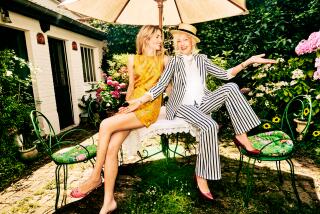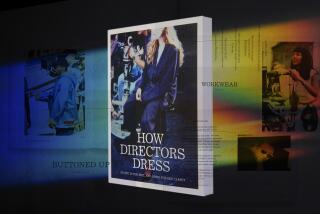FASHION 89/Magazines : Tale of Two Editors and Two Magazines : Wintour Puts a New, More Informal Face on Fashion Mags’ Grande Dame
Anna Wintour started attracting attention well before she moved into the editor’s office at Vogue magazine 11 months ago. But now she even steals the spotlight at fashion shows.
It happened this spring in New York when Marc Jacobs, the new designer for Perry Ellis, noticed Wintour in the front row at his show, shot an insecure look in her direction and shouted from the runway: “Was it all right?”
Heads swiveled toward Wintour, who smiled in characteristic noncommitment, just as she did several days later when Giorgio di Sant’ Angelo, another New York fashion maker, knelt down on the runway after his show and kissed her in apparent homage.
Asked about it later, Wintour said: “I’m thrilled if you think designers want to kiss Vogue.”
“People are just getting to know Anna Wintour; they want to be sure they have her approval,” suggested another up-and-coming New York designer, Isaac Mizrahi, about Jacobs’ behavior. “Not that the magazine is so powerful it can make or break a designer.” A moment later he reconsidered: “I live for Vogue. Everyone does.”
If not everyone, certainly anyone who wants to be included in the magazine’s fashion pages. For them, getting close to Wintour is a priority right now. But it’s not an easy thing to do. She is described as shy, and the fact that she hides behind black sunglasses day and night, indoors and out, makes her seem all the more elusive, even though she says she only wears them to protect hypersensitive eyes. She talks openly about certain aspects of her life, such as the fact that she is British-born, 39, and that her father, Charles Wintour, a prominent newspaper journalist, was managing editor of the London Daily Express when she was growing up. Her husband, Dr. David Shaffer, is chief of child psychiatry at Columbia Presbyterian Medical Center in Manhattan and she has two small children, Charles, 3, and Katherine, 2.
But other facts about Wintour are more difficult to confirm, so that gossip buzzes about everything from her salary at Vogue ($200,000 or $600,000 depending on which rumors you believe) to her Conde Nast-supplied clothing allowance ($25,000 or possibly $100,000, most of which she spends on Chanel suits and Geoffrey Beene evening dresses). She will only say that she earns far less than $600,000, and that her clothing budget is small.
She shops from Polaroid pictures she takes at fashion shows or during visits to designer showrooms, ordering the outfits by phone. As for whose labels she wears, Wintour said: “I make an effort to wear others, (aside from Chanel and Beene), but I feel it’s unnecessary. I support the designers in the magazine.”
People who have worked with Wintour describe her as dedicated and decisive but not always diplomatic. Rubbish is her favorite word for employees’ failed attempts at creativity. The masthead changed considerably at Vogue when she became editor, which seemed to justify to some past employees a nickname that followed her from England--”Nuclear Wintour.”
Removed From Rumors
But in her sparsely decorated office with its white walls and white tile floor, Wintour seems removed from all the rumors and rumblings, and completely focused on her work, which includes everything from choosing the clothes to be worn in fashion layouts to meeting with art directors about how to lay out the pictures.
“To produce a magazine that is cutting-edge, to convince designers that it is cutting-edge, but at the same time to show enough clothes that readers can actually wear, is a balancing act,” she said about her job. The average Vogue reader is 29 years old, college-educated, and 75% of readers are married, Wintour said about the women she appeals to. Although she refers to Vogue as an icon, she has not been afraid to change it for the sake of attracting modern-minded readers.
“Women don’t want to look perfect anymore,” she said, explaining the very informal cover shots she has featured since she became editor. Her own dress style, however, is surprisingly reserved. She wore a meticulous navy blue suit with matching hosiery and mid-heel, leather pumps on a recent day spent between the office and the New York collection shows. But her tailored bob haircut was a bit out of place, and her only visible makeup was her near-natural shade of lipstick.
“I like a style that is real, not plastic and perfect. I like to photograph people who look accessible,” she said. “That’s a change of attitude at Vogue.”
It might be the key change. And the strongest proof of it yet appears in the May issue, the cover story of which is pop singer Madonna and her eccentric Beverly Hills house.
“She’s done so much for style in this country,” Wintour explained about the not very Vogue-y choice--at least not by old regime standards.
Rejecting the formal, beauty-portrait image of the magazine under Grace Mirabella, her predecessor, Wintour may, at first, have gone a bit too far toward the very youthful Elle magazine look. Early covers that she authorized were of a young model romping on a beach in an Yves Saint Laurent jacket over a bikini swimsuit and a city girl in a bejeweled, couture T-shirt tucked into blue jeans. But she considers such photos “elements of surprise” and says she will include other surprises in every issue.
The Madonna cover came close to a Vanity Fair look-alike, but Wintour defended it.
“Our beat is fashion and fitness, Vanity Fair’s is society and politics, but they put Ralph Lauren and Calvin Klein on their cover,” she said. “We’re not going to slap a personality on the cover very often, people will say we’re copying.” “She has very distinct ideas, and I have a feeling she gets what she wants,” Mizrahi said about Wintour, an impression supported by her speedy and always escalating career.
She started in London at Harpers & Queen magazine, went on to New York where she was fashion editor for Harper’s Bazaar, then senior editor for fashion and interior design at New York magazine, and finally, creative director of American Vogue.
Afterward she was named editor-in-chief of British Vogue, a job to which she commuted from New York to London for two years, followed by editor-in-chief of HG for just seven months. In those few months she changed the magazine’s name from House & Garden and changed its image to include so many celebrity profiles and fashion layouts in the manner of Vanity Fair that staffers called HG, “Vanity Chair.”
Asked about the inelegant way that Grace Mirabella first heard she was being replaced by Wintour--a New York gossip columnist reported it--Wintour said: “I don’t think anyone here is particularly proud of that.”
As for the new Vogue, Mizrahi predicts: “A year from now it will be a whole other kind of magazine, not just about fashion, about fashion as it relates to the rest of life.”






